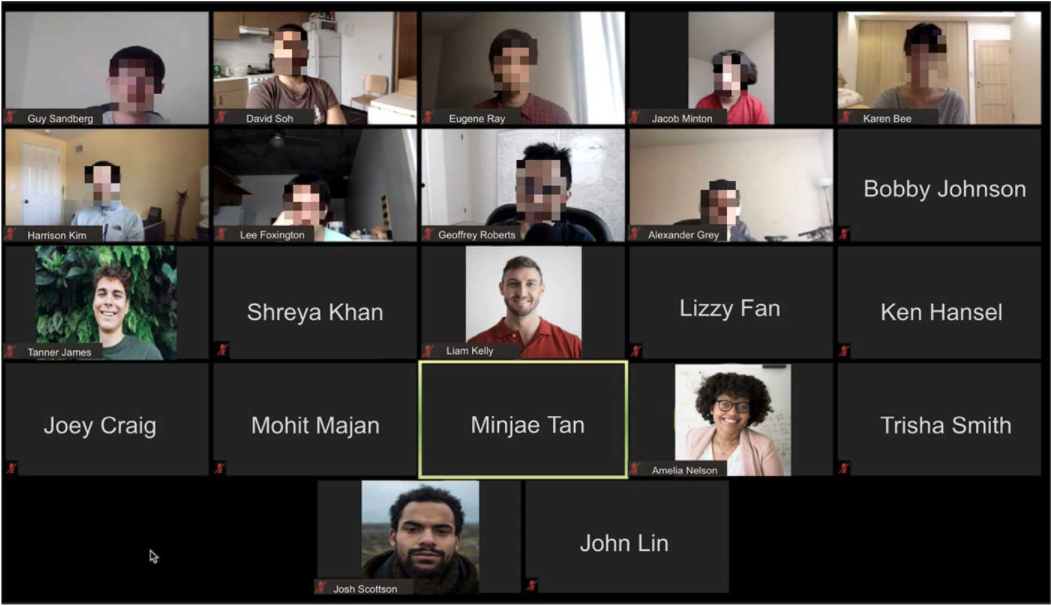News Release
'It Feels Like I'm Talking into a Void': How Do We Improve the Virtual Classroom?
 |
| A pseudonymous snapshot of a discussion-based lecture at Â鶹´«Ã½. Most students are not sharing videos and all are muted except the one person who is speaking. |
June 17, 2021--The COVID pandemic precipitated a major shift to virtual learning—an unplanned test of whether these technologies can scale effectively. But did they?
Researchers in the Â鶹´«Ã½ Department of Computer Science and Engineering wanted to look beyond the anecdotal evidence to better understand where remote education fell short and how we might improve it. In a study presented at the Association for Computing Machinery’s (CHI), the team examined faculty and student attitudes towards virtual classrooms and proposed several technological refinements that could improve their experience, such as flexible distribution of student video feeds and enhanced chat functions.
“We wanted to understand instructor and student perspectives and see how we can marry them,” said Nadir Weibel, a computer science associate professor and senior author on the paper. “How can we improve students’ experience and give better tools to instructors?”
The project was initiated and led by computer science Ph.D. student and first author Matin Yarmand. With coauthors Scott Klemmer, a professor of cognitive science and computer science, and Carnegie Mellon University Ph.D. student Jaemarie Solyst, the team interviewed seven Â鶹´«Ã½ faculty members to better understand their experience. Their primary fault with online learning is that many students never turn their cameras on.
“When I’m presenting the lecture content, it feels like I’m talking into a void,” said one professor. “How do I tell whether students are engaged?” asked another. “You have no sense if people are getting it or not getting it.”
The researchers then distributed student surveys. The 102 responses they showed—not surprisingly—that students resist turning on their cameras and often remain muted. Some don’t want their peers to see them; others are eating or performing unrelated tasks; some are unaware video feedback helps instructors; and a hardcore few see no need to turn their cameras on at all.
While students feel awkward asking questions on video, they overwhelmingly like chat functions, which make them more likely to participate. “I’m more comfortable asking questions in chat, since I feel less like I’m interrupting the lecture,” said one respondent. The survey also showed chat rooms drive more community among students. As a result, the authors propose that text communication could promote student engagement and community, even in in-person classrooms.
Students also have trouble connecting with instructors. Online classes lack opportunities for short conversations and questions that can happen during “hallway time” before and after live lectures.
Gathering together, virtually
.png) |
| The Gather lounge contains the instructor’s office in the middle and many other spaces for student collaboration. The red ellipses indicate small group interactions that are taking place before the lecture starts. |
In response to these concerns, the researchers have suggested potential solutions. Technology that reads social cues, such as facial expressions or head nods, could provide invaluable feedback for instructors. Video feeds could also be refined to make instructors the center of attention, as they are in real-life classrooms, rather than one of many co-equal video boxes.
Increased chat use could improve both online and in-person classes, as some students have always been reluctant to call attention to themselves.
Weibel and colleagues have also been exploring how virtual reality environments could improve online learning. Using a tool called , they have been testing an instructor lounge, in which students and faculty could meet before or even during class.
“The way Gather works is you move your avatar around in the space, and if it gets close enough to somebody, you can have a one-to-one conversation with just that person,” said Weibel. “Nobody else is part of it. People can just come and talk to me directly or chat with their friends and peers.”
The team is also working on a natural language processing bot that could make the experience more interactive. For example, if two people are struggling on the same assignment, it could connect them to improve collaboration or point to additional resources on Canvas.
The authors believe online classes, such as MOOCs, which were popular before COVID, will continue into the future. Weibel hopes this research and other efforts will refine the technology and improve the online learning experience.
“Some classes will be back in person,” he said. “Some will be only online and some will be hybrid, but I think online learning is probably here to stay.”
Media Contacts
Joshua Baxt
Computer Science and Engineering Writer
000-000-0000
none@none.none